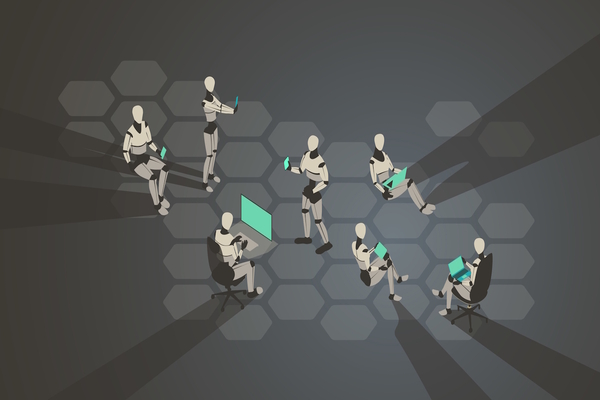Creating presentations with impact

Kris Flegg at Presentation Design Co explains why most presentations fall flat and how to avoid this happening
Picture an afternoon in presentation hell.
It’s just after lunch at a financial services conference. People who were happily grazing the sandwich buffet are now shepherded into yet another dimly lit room. A bland PowerPoint appears on the screen.
And so it begins.
A couple minutes in, the audience has lost the thread. By the five-minute mark, there are yawns. Any hope of engagement disappeared a long time ago. The presenter powers through, but they know it’s a lost cause. The PowerPoint wraps up, no questions, and everyone shuffles out in silence.
Sound familiar?
To me it does. I’ve been that post-lunch presenter who lost the war for my audience’s attention. It was embarrassing, but it marked the moment I decided to make a change.
I was fed up with being boring. I desperately wanted to do better, and that experience became my fuel. My passion for improving and the work that I do now – leading a presentation agency – all stems from that chastening experience.
And I’m here to share with you why most presentations fail to have an impact and what you can do about it.
The mistake that kills most presentations
Ten years at the coalface, working with clients to deliver impactful presentations, has shown me plenty of what not to do. I’ve seen a lot of failures over the years.
Part of the trouble is that these failures are subtle. They don’t usually fail spectacularly. Instead, they simply fade away into a box of ‘meh’. No matter the intentions of the speakers, many simply miss the opportunity to deliver. They make no impact. They don’t change anything.
And that’s because they’re focused on entirely the wrong thing. Most presentations are only concerned with what they’re talking about, and not what they want to achieve. Failing to identify the purpose of your presentation will kill it before it even begins.
Start with your end objective
Every presentation is a journey. You are taking your audience from wherever they are at the start before you open your mouth, and transporting them to a new enlightened state. When you click through to that final slide, you want them to have changed somehow.
It could be embracing a new way of thinking, making a positive decision about you or your product, or understanding a shared mission.
Whatever the single, clearly defined purpose of your presentation – and it must have one, just one, no matter how complex you think the topic is – everything else must build towards that.
Only once you have that clarity can you start to create a journey for your audience: from before your presentation to their changed state after it.
Looking back at the closing moments of your last presentation, what were your final words? How did you make your audience feel? What was the interaction immediately after you finished presenting? What happened in your moment of truth? Did you get what you wanted or were you greeted by silence?
Defining your purpose is the first step in building a journey for your audience.
Do tools make a difference?
For a long time, PowerPoint was the only available option, but that’s no longer the case. Prezi is a relative newcomer to the presentation scene. If you haven’t seen it before, it’s a big, open canvas that allows you to zoom in and out of content in a non-linear way.
On the surface, it’s very different from the linear nature of a slideshow. Done right, it can look amazing. We’ve had plenty of clients come to us excited to step outside the constraints of slides and give their presentation movement using Prezi.
We built some very successful presentations with these clients. And so it was easy to think that the impact was coming from the software; that Prezi was making the difference. But bad Prezis can be the worst presentations possible.
If you skip the planning and place content haphazardly into Prezi, it’s a dizzying, nauseating roller coaster of an experience, with your screen spinning out of control. If you’ve seen a bad Prezi, you’ll know exactly what I mean.
What was making the presentations effective was the work required to make a great Prezi. That involves organising content in a hierarchical order to support the smooth animation that the software offers.
When we worked on Prezis with clients, we needed to organise and map content in a meaningful way, and ensure things were grouped together in topics. The first step was to decide on a home screen theme, high-level content groups, and then the content in each group.
Before any design work started, we had to map out a storyboard of content. We needed to see how everything fitted together. Clients needed to think deeply about the architecture of their presentation.
This is where the transformation to a much more impactful presentation started to occur; it was the work before the Prezi that made their presentation stronger. The Prezi then simply brought it to life in a more visual way.
The years of experience seeing the dramatic improvement in the impact clients made led us to develop this clear and practical belief: context comes before content.
The shocking truth
When you start with the objective and the logical flow of information to get there, you set yourself up for success. And so most of our work these days is in PowerPoint.
Yep, I said it.
We’re an award-winning presentation company, experts in the tech we use, and we choose to use PowerPoint.
But we use this ’context first’ mindset and process as if we’re designing a Prezi, and we create PowerPoint slides in a different way than most to create visually appealing decks.
But the key to our success is that mindset and that process.
Define your end goal
An entire presentation should be able to be distilled and explained with a high-level 20-30 second overview. That doesn’t change no matter what the presentation is.
It’s the DNA that sets out the flow of content. If you aren’t able to distill your presentation into a high-level overview first, the entire process of creating it is harder and it’s not going to make the impact you want it to have.
Kris Flegg is a certified Platinum Prezi Expert and the founder and director of Presentation Design Co. He is the author of “The Presentation Playbook”.
Main image courtesy of iStockPhoto.com and Wavebreakmedia

Business Reporter Team
Related Articles
Most Viewed
Winston House, 3rd Floor, Units 306-309, 2-4 Dollis Park, London, N3 1HF
23-29 Hendon Lane, London, N3 1RT
020 8349 4363
© 2025, Lyonsdown Limited. Business Reporter® is a registered trademark of Lyonsdown Ltd. VAT registration number: 830519543





